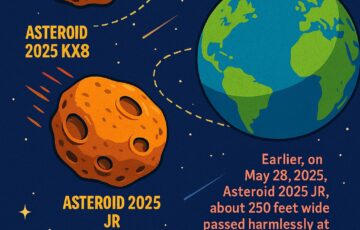Asteroid YR4 May Miss Earth, Hit Moon
Asteroid YR4 May Miss Earth, Hit Moon
Why in the News ?
NASA recently announced a 3.8% chance of asteroid YR4 colliding with the moon on December 22, 2032. Earlier flagged for possible Earth impact, latest data shows it poses no significant threat to Earth but may still affect the Moon.
Discovery, Classification, and Risk Analysis:
- Asteroid 2024 YR4 was discovered in December 2024 using the ATLAS telescope in Chile.
- It is a near-Earth asteroid, orbiting closer to the Sun than Earth.
- Initially believed to pose a 1% risk to Earth, NASA later ruled out this threat.
- The James Webb Space Telescope estimated its size at 65 meters, below the 140-meter threshold for being classified as potentially hazardous.
Possibility of Moon Impact and Its Implications
- NASA now projects a 8% chance of YR4 hitting the moon on 22 December 2032.
- If it strikes, it would create a 500–2,000 metre-wide crater with an energy impact 340 times greater than the Hiroshima bomb.
- Such a collision wouldn’t affect the Moon’s orbit, but could offer valuable insights into lunar regolith.
- Observatories like Chandrayaan-2 may witness this potential impact.
Ongoing Monitoring and Preparedness
- Automated algorithms now identify most near-Earth objects using successive sky images.
- Uncertainty in orbit data from new discoveries leads to evolving predictions.
- YR4 will approach Earth again in 2028, offering another chance for data refinement.
- Scientists stress that asteroids remain the only preventable natural disaster through proactive tracking and response systems.
Asteroids and Their Potential Threats – Key Points● Asteroids are small, rocky bodies orbiting the Sun, mostly found in the asteroid belt between Mars and Jupiter. ● Formed 4.6 billion years ago, they are irregular in shape and are solar system remnants. ● Some asteroids, called Near-Earth Objects (NEOs), cross Earth’s orbit and are monitored for collision risks. ● Thousands enter Earth’s atmosphere daily, but most burn up on entry. ● Large impacts (1 km wide) like the Chicxulub asteroid are extremely rare (~once every 260 million years). ● Smaller asteroids (e.g., Chelyabinsk) can cause regional damage or city-level destruction if over 40 meters wide. |





